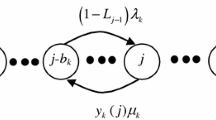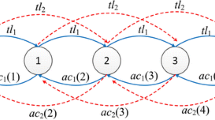Abstract
The paper considers a problem of deriving the multidimensional distribution of a segment of a long-range dependent traffic in the third generation mobile communication network. An exact expression for the probability is found when a self-similar process from [8] models the traffic. The probability of heavy-traffic period, the outage probability, and the level-crossing probability are found. It is shown that the level crossing probability depends on the average call length only. Further, this probability for traffic with dependent samples is lower than for traffic with independent samples. Also, it is shown that there is a linear dependence between the average heavy traffic interval and the average call length.
Similar content being viewed by others
References
J. Abrahams, A survey of recent progress on level-crossing problems for random processes, in: Communications and Networks - A Survey of Recent Advances, eds. I.F. Blake and H.V. Poor (Springer, New York, 1986).
J. Beran, R. Sherman, M.S. Taqqu and W. Willinger, Long-range dependence in variable-bit-rate video traffic, IEEE Transactions on Communications 43 (February-April 1995) 1566–1579.
M.E. Crovella and A. Bestavros, Self-similarity in World Wide Web traffic: evidence and possible causes, IEEE/ACM Transactions on Networking 5 (May 1997) 835–846.
M.R. Leadbetter, G. Lindgren and H. Rootzen, Extremes and Related Properties of Random Sequences and Processes (Springer, New York, 1983).
W.E. Leland, M.S. Taqqu, W. Willinger and D.V. Wilson, On the self-similar nature of Ethernet traffic (extended version), IEEE/ACM Transactions on Networking 2 (February 1994) 1–15.
N.B. Mandayam, Pi-Chen and J.M. Holtzman, Minimum duration outage for CDMA cellular system: a level crossing analysis, Wireless Personal Communications 7 (July 1998) 135–146.
B. Tsybakov and N.D. Georganas, Self-similar traffic and upper bounds to buffer-overflow probability in ATM queue, Performance Evaluation 32 (February 1998) 57–80.
B. Tsybakov and N.D. Georganas, Self-similar processes in communications networks, IEEE Transactions on Information Theory 44 (September 1998) 1713–1725.
A.J. Viterbi, CDMA - Principles of Spread Spectrum Communication (Addison-Wesley, New York, 1995).
A.M. Viterbi and A.J. Viterbi, Erlang capacity of a power controlled CDMA system, IEEE Journal on Selected Areas in Communications 11 (June 1993) 892–900.
M. Zorzi, Minimum duration outages in Markov channels, in: Proc. IEEE ICUPC'97 (San Diego, 1997) pp. 583–587.
Author information
Authors and Affiliations
Rights and permissions
About this article
Cite this article
Tsybakov, B. Probability of Heavy Traffic Period in Third Generation CDMA Mobile Communication. Mobile Networks and Applications 6, 463–470 (2001). https://doi.org/10.1023/A:1011430700986
Issue Date:
DOI: https://doi.org/10.1023/A:1011430700986




